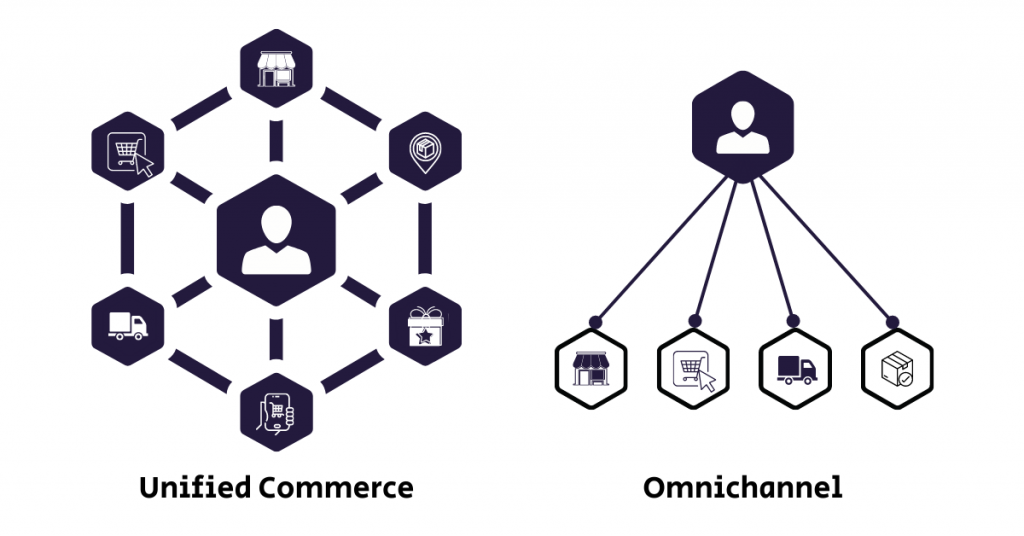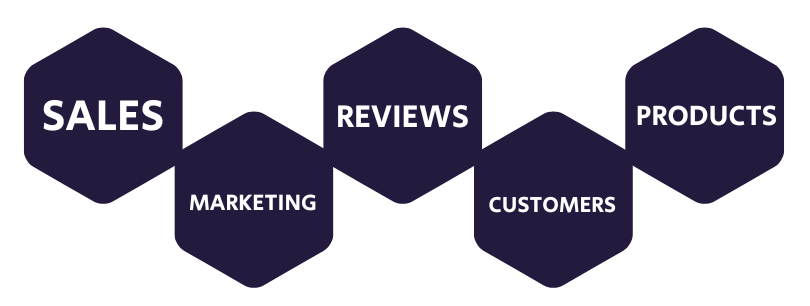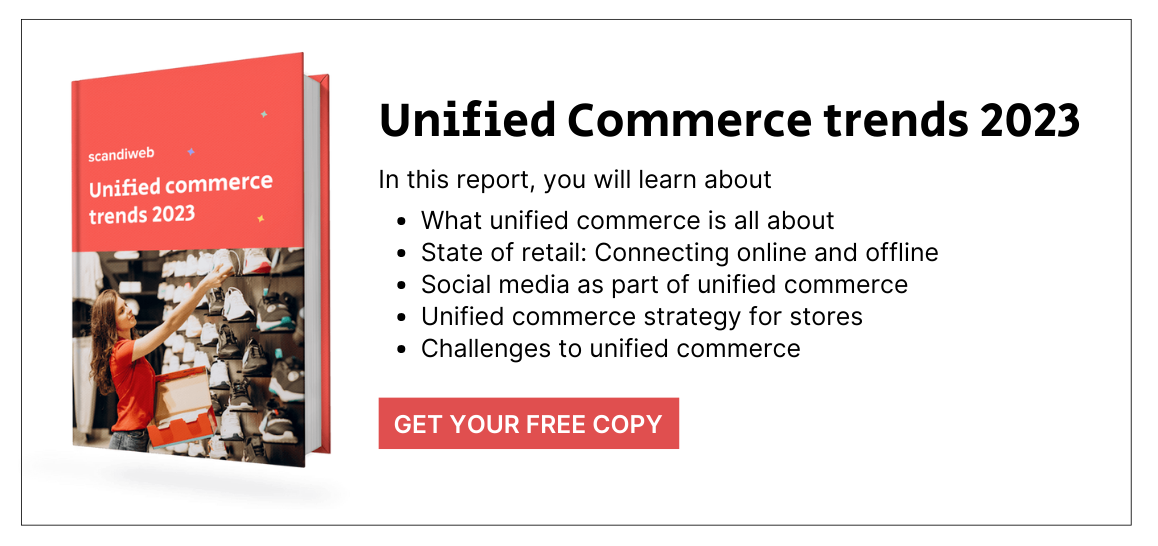Welcome to the first installment in our Unified Commerce series, where we’ll explore the world of unified commerce and discover how Magento (Adobe Commerce) empowers retailers to implement this game-changing retail strategy. In today’s post, we’ll dive into the concept of unified commerce, discuss its importance in the current retail landscape, and see how Magento (Adobe Commerce) serves as the perfect platform for retailers to embark on this journey.
What is Unified Commerce?
Unified commerce is a holistic approach to retail that focuses on creating a seamless integration of customer experiences across all sales channels, including physical stores, online platforms, and mobile applications. This retail strategy aims to break down the barriers between different channels to provide a consistent and cohesive experience to customers, no matter how they choose to interact with your brand.
Why is Unified Commerce important?
In the fast-paced and ever-evolving world of retail, keeping up with customer expectations is crucial for staying ahead of the competition. Unified commerce addresses this challenge by empowering retailers in these areas:
- Meeting evolving customer expectations: Today’s customers demand a seamless, personalized, and consistent experience across all channels. Unified commerce enables retailers to deliver on these expectations, fostering customer loyalty, and increasing sales.
- Gaining a competitive edge: By adopting a unified commerce strategy, retailers can differentiate themselves from competitors who are still operating in siloed channels, providing a better overall experience for their customers.
- Boosting operational efficiency: Integrating different sales channels and streamlining processes through unified commerce can lead to improved operational efficiency, saving time and reducing costs.
Unified Commerce vs Omnichannel

Omnichannel retailing focuses on providing a seamless and consistent customer experience across all channels, including online, brick-and-mortar, mobile, and social media. The goal is to enable customers to engage with the brand through the channel of their choice, while maintaining a consistent brand identity and customer experience. Omnichannel retailing emphasizes the integration of channels, but the channels themselves remain distinct.
Unified commerce, on the other hand, takes the integration of channels a step further by creating a single, centralized platform for all sales channels. Unified commerce aims to break down the barriers between channels by creating a seamless and cohesive experience for customers, regardless of the channel they use to interact with the brand. Unlike omnichannel retailing, which focuses on integrating channels, unified commerce aims to create a single, unified view of the customer across all channels.
Some marketers and eCommerce businesses use the terms “omnichannel” and “unified commerce” interchangeably, but it’s important to understand the differences between the two. While both approaches aim to provide a seamless customer experience across all channels, the approach to integration differs significantly. Unified commerce is a more comprehensive strategy that seeks to create a single, unified platform, while omnichannel retailing focuses on integrating channels while maintaining their distinct identities.
Ultimately, whether you choose an omnichannel or unified commerce strategy will depend on your business needs and goals. However, understanding the differences between the two approaches is crucial for making informed decisions and ensuring that you select the strategy that best fits your business.
How Magento enables Unified Commerce
Magento (Adobe Commerce) is a comprehensive and customizable platform designed to help retailers implement a successful unified commerce strategy. Its extensive range of features and integrations allows retailers to adapt the platform to their specific needs, while taking advantage of cutting-edge retail technologies.
Let’s take a look at how Magento (Adobe Commerce) enables the following in a unified commerce environment:
- Seamless shopping experience across channels
- Customer management
- Multi-source inventory
- Unified order fulfillment
- Data visibility

Seamless shopping experience across channels
In today’s retail landscape, customers are increasingly shopping across multiple channels, such as online, in-store, and through mobile devices. A disjointed shopping experience across these channels can negatively impact customer satisfaction and loyalty. This is why providing a seamless shopping experience across channels is crucial for businesses looking to implement unified commerce. In this section, we will explore the importance of a seamless shopping experience across channels and how businesses can achieve it with Magento (Adobe Commerce).
1. Magento is PWA-ready
45% of consumers shopped on mobile devices in 2022, according to YouGov. Businesses need to be mobile-ready to reach shoppers where they are. Magento is PWA-ready, meaning it can deliver an app-like experience through a mobile browser. With PWA, businesses can provide a seamless experience for customers shopping on their mobile devices, leading to higher conversion rates. By optimizing for mobile shopping, businesses can provide a better user experience and increase the chances of a successful sale.
2. Magento offers robust POS integration
Unified commerce relies on a seamless connection between online and brick-and-mortar stores. Magento’s POS integration enables retailers to bridge the gap between these channels. An integrated POS system ensures that all sales transactions, whether online or offline, are processed and tracked through a centralized system. Whether customers choose to buy online and pick orders up in-store or make a purchase in the store and have it delivered to their doorstep, retailers can offer a seamless shopping experience.
Data between an integrated POS system and Magento are updated in real time, providing accurate stock information to customers and helping merchants manage their inventory more effectively.
3. Magento supports in-store apps
In-store apps offer retailers a powerful tool to enhance the customer experience in physical stores, providing personalized recommendations, self-checkout options, and empowering sales associates with information and tools to assist customers. This not only improves the customer experience but also enhances operational efficiency.
Magento (Adobe Commerce) supports in-store apps that can enhance the shopping experience for customers and improve operational efficiency for retailers. These in-store apps can be developed using Magento’s open-source software development kit (SDK) and can be integrated with the POS system to provide a seamless shopping experience across sales channels.
Here are some examples of in-store apps that can be developed using Magento:
- Self-checkout: Customers can scan items with their mobile devices, add them to their cart, and complete their purchase using a self-checkout kiosk or their mobile device.
- Mobile coupons: Customers can receive and redeem coupons on their mobile devices, increasing the likelihood of in-store purchases.
- Product recommendations: Customers can receive personalized product recommendations based on their browsing and purchase history, enhancing the shopping experience and increasing the likelihood of additional sales.
In addition to the native features of Magento, there are also a variety of extensions that can add additional functionalities to in-store apps. Examples of these extensions include:
- Scandit Smart Data Capture: A barcode scanning software the turns smart devices into high-performance data capture instruments, allowing for automation of end-to-end processes without the need for dedicated scanning devices.
- Magento POS by BoostMyShop: This extension provides a fully integrated POS system that can be used in physical stores, allowing sales associates to process transactions, manage inventory, and access customer data from a single location.
- Barcode Scanner by Store Manager for Magento: This extension allows retailers to use barcode scanning at checkout, improving efficiency and reducing the risk of errors.
- Magestore’s Magento 2 Click and Collect: This extension allows customers to buy online and pick up their orders in-store, providing a convenient and seamless shopping experience.

Customer management: Keeping shoppers happy
Customer management is a critical aspect of unified commerce, as it directly impacts overall customer experience and satisfaction. As businesses expand their reach across multiple channels, managing customer interactions becomes increasingly complex. By effectively managing customer interactions and keeping shoppers happy, businesses can build trust with their customers, increase customer loyalty, and ultimately drive sales. In this section, we will explore the importance of customer management in unified commerce and discuss how Magento (Adobe Commerce) can help businesses achieve this.
1. Magento natively supports Unified CRM
Unified Customer Relationship Management (CRM) is a business strategy that seeks to offer customers a seamless and personalized experience across all touchpoints and channels. It involves consolidating customer data from various sources into a single view, enabling businesses to better understand their customers’ behaviors, preferences, and needs. With a comprehensive customer data management system, businesses can manage customer interactions across all channels, track customer behavior, and analyze customer data to make informed business decisions. The goal of unified CRM is to provide a consistent experience across all channels, building trust with customers, driving sales, and increasing customer loyalty.
Magento (Adobe Commerce) support unified CRM natively through its integration with Adobe Experience Cloud. Adobe Experience Cloud is a suite of products that includes Adobe Analytics, Adobe Target, and Adobe Campaign, among others, that help businesses manage customer data, personalize customer experiences, and optimize marketing campaigns.
The integration between Magento (Adobe Commerce) and Adobe Experience Cloud allows businesses to unify customer data across all channels, enabling them to deliver personalized experiences to their customers. Additionally, there are a variety of third-party extensions available in the Magento (Adobe) Marketplace that can add additional CRM functionalities to the platform. These extensions can help businesses manage customer data, automate marketing campaigns, and provide personalized experiences to their customers.
2. Magento makes loyalty program management easy
A loyalty program is essential for a unified commerce strategy because it helps businesses retain customers by providing them with a personalized shopping experience and rewarding them for their loyalty. By centralizing customer data and creating different promotions based on custom behavior-based rules, businesses can incentivize customers to continue buying products, referring friends, and celebrating special occasions. This, in turn, builds trust with customers and drives sales across all touchpoints and channels, whether online or at physical stores. Ultimately, a loyalty program is a key component of a unified commerce strategy as it helps businesses build lasting relationships with their customers and increase customer loyalty.
Here are some of the key features and functionalities that Magento (Adobe Commerce) offers to support loyalty programs:
- Customizable promotions: Magento allows retailers to create custom promotions to target different customers and offer them rewards for their loyalty. Promotions can be created based on customer behavior, such as purchase history, order value, and other customer data.
- Reward point program: Adobe Commerce 2.3 comes with a built-in Reward Point Program that allows customers to earn and redeem points based on their shopping behavior. Retailers can set up rules to define how customers earn points, such as making purchases, referring friends, or participating in promotions. Customers can then redeem these points for discounts or other rewards.
- Tier pricing: Magento supports tier pricing, which allows retailers to offer different pricing for different customer groups based on their loyalty levels. This encourages customers to buy more by offering discounts for bulk purchases or for reaching certain loyalty thresholds.
- Coupon codes: Magento allows retailers to create coupon codes that can be used as rewards for loyalty program members. These codes can be customized to target specific customers or offer discounts on specific products or categories.
- Loyalty point balance: Magento allows customers to view their loyalty point balance and transaction history through their account dashboard. This helps customers keep track of their rewards and encourages them to continue shopping with the retailer.
Also read:
Top Customer Loyalty Trends in 2023
Your Guide to Setting Up Loyalty Programs That Work
20 Great Customer Loyalty Program Examples by Industry
3. Unified customer service
Customers expect consistent, high-quality customer service across all sales channels, whether it’s through a physical store, online platform, or mobile application. Retailers that fail to meet these expectations risk losing customers and damaging their reputation.
Unified commerce addresses this challenge by providing a seamless integration of customer service across all channels. This means that customers can expect the same level of service, no matter how they choose to interact with the brand.
Magento (Adobe Commerce) offers a range of customer service features and functionalities that can help businesses provide a seamless and personalized customer service experience across all channels and touchpoints. For more advanced functionality, numerous extensions are also available in the marketplace.
- Omnichannel support: Magento supports multiple channels such as email, chat, social media, phone, and in-store interactions. This enables businesses to manage customer service inquiries and interactions across all channels from a single dashboard.
- Customer management: Magento’s customer management system allows businesses to centralize customer data from various sources, including purchase history, order status, and communication history. This enables businesses to provide personalized and targeted customer service based on the customer’s preferences, behaviors, and history.
- Self-service options: Magento also offers self-service options for customers, including order tracking, returns management, and account management. These self-service options can help reduce the workload on customer service teams and improve the overall customer experience.
- Integration with third-party tools: Magento can integrate with third-party customer service tools such as Zendesk, Freshdesk, and Salesforce Service Cloud, which can help businesses streamline customer service operations and provide a seamless experience across all channels.

Multi-source inventory
Inventory management is a critical component of a unified commerce strategy. By optimizing inventory management, businesses can ensure that they have the right products in stock, in the right quantities, and in the right locations to meet customer demand across all sales channels.
Magento’s Multi-Source Inventory (MSI) is a feature that allows businesses to manage inventory across multiple sources and locations, such as warehouses and physical stores. MSI provides a centralized dashboard where businesses can manage inventory levels, set up rules for inventory allocation, and track inventory across all sources. Some of the key features and functionalities of MSI include:
- Real-time inventory management: MSI enables businesses to manage inventory levels in real time, ensuring that stock levels are accurate and up-to-date across all channels.
- Inventory allocation rules: Businesses can set up rules for how inventory is allocated across different sources and locations, such as warehouses and physical stores. This enables businesses to optimize inventory management and reduce the risk of stockouts or overstocks.
- Order management: MSI also enables businesses to manage orders across all sources and locations, ensuring that orders are fulfilled from the most appropriate source based on inventory levels and customer location.
- Reporting and analytics: MSI provides detailed reporting and analytics on inventory levels, orders, and fulfillment, enabling businesses to gain insights into their supply chain operations and make data-driven decisions.
Magento (Adobe Commerce) can support product availability check for products, including:
- Real-time inventory management: With the right extension, retailers can manage their inventory in real time, i.e., the availability of a product is updated automatically as soon as a purchase is made. This ensures that customers have accurate information on product availability, and retailers can avoid overselling or underselling products.
- Product Availability widget: Magento also has a Product Availability widget that allows customers to check the availability of a product on the product page itself. This feature can be customized to display different messages based on product availability, such as “In Stock,” “Out of Stock,” or “Available for Pre-Order.”

Unified order fulfillment
Unified order fulfillment is the process of fulfilling orders across all channels and touchpoints in a seamless and integrated manner. In unified commerce, customers expect to be able to purchase products through multiple channels, including online, in-store, and mobile, and to receive their orders in the way that’s most convenient for them. Unified order fulfillment ensures that businesses can meet these expectations by providing a consistent and personalized experience across all channels.
Unified order fulfillment typically involves the integration of various systems and processes, including inventory management, order processing, and shipping and delivery. By centralizing these systems and processes, businesses can ensure that they have real-time visibility into inventory levels and order status, and can fulfill orders from the most appropriate source based on customer location, inventory levels, and other factors.
Here are the different shipping options natively supported by Magento (Adobe Commerce):
- In-store pickup: Customers can choose to purchase products online and pick them up in-store. The store staff fulfills the order and sets it aside for pickup by the customer.
- Ship from store: Businesses can fulfill orders from their physical store locations and ship them directly to customers. This enables businesses to leverage their store inventory to fulfill online orders and improve order fulfillment speed and efficiency.
- Real-time carrier rates: Magento supports real-time carrier rates, which allows businesses to provide customers with accurate and up-to-date shipping rates based on carrier rates.
- Flat rates: Businesses can set up flat rates for shipping based on order value, weight, or other criteria.
- Free shipping: Businesses can offer free shipping for orders above a certain value, or as part of a promotional offer.
Magento (Adobe Commerce) does not natively support a “buy in-store, home delivery” model as a single transaction, but businesses can leverage Magento’s built-in order management, inventory management, and shipping options to provide this type of service. This can be achieved by allowing customers to purchase products in-store and setting up a shipping option to have the products delivered to their home, or by having the products shipped to their home from a central warehouse or distribution center.
With advanced Magento (Adobe Commerce) extensions, dropshipping can also be supported, allowing businesses to sell products without holding inventory. With dropshipping, suppliers or vendors fulfill orders directly to customers, and businesses can manage orders and shipping from their Magento dashboard.
With third-party extensions, a return anywhere feature can also be enabled. These extensions or services can allow customers to return products purchased online to a physical store or drop-off location, for example, providing a more convenient and seamless customer experience.

Data visibility
Magento (Adobe Commerce) provides a range of built-in reports that can be useful for businesses to track their performance and optimize their unified commerce strategy. Here are some examples of reports that can be useful for a unified commerce strategy:
- Sales reports: These reports provide insights into sales performance, including sales by product, sales by customer, and sales by region. This can help businesses identify trends and opportunities to optimize their sales strategies across all sales channels. Examples of sales reports include the Sales by Product Report and the Sales by Region Report.
- Customer reports: These reports provide insights into customer behavior and preferences, including purchase history, loyalty program participation, and customer lifetime value. This can help businesses tailor their marketing and sales strategies to meet the needs of their customers better and enhance customer satisfaction and loyalty. Examples of customer reports include the New vs. Returning Customers Report and the Customer Segments Report.
- Marketing reports: These reports provide insights into marketing performance, including the effectiveness of promotional campaigns and customer acquisition and retention rates. This can help businesses optimize their marketing strategies across all sales channels, ensuring that they are reaching the right audiences with the right messages. Examples of marketing reports include the Abandoned Carts Report and the Sales by Coupon Code Report.
- Review reports: These reports provide insights into customer reviews and ratings for products. Examples of review reports include the Top Rated Products Report and the Most Helpful Reviews Report.
- Product reports: These reports provide insights into product performance, including sales and inventory levels. Examples of product reports include the Low Stock Report and the Bestsellers Report.
- Private sales reports: These reports provide insights into private sales, such as those for wholesale or VIP customers. Examples of private sales reports include the Private Sales by Customer Group Report and the Private Sales by Product Report.
Conclusion
Unified commerce is a crucial retail strategy for providing customers with a seamless and consistent shopping experience across all channels.
Magento (Adobe Commerce) is a robust eCommerce platform that provides a unified backend for managing multiple sales channels, inventory, payment systems, and customer data. However, to fully leverage the platform’s capabilities, retailers need to build a comprehensive unified commerce ecosystem, which may include integrating other systems such as PIM, OMS, ERP, and CRM. While Adobe Commerce has features supporting unified commerce, customizations and third-party integrations are necessary components of that ecosystem. Then again, by using Magento as the base platform, businesses can manage all of the systems from a single, centralized location, allowing for greater efficiency, streamlined operations, and an enhanced customer experience.
In our next post, we’ll dive deeper into implementing a Unified Commerce strategy with Magento (Adobe Commerce) and explore best practices and case studies to help retailers achieve success in this endeavor. So, stay tuned!
Excited by the promise of unified commerce? Get in touch today and we’ll create a roadmap specific to your business needs. What we’ve shared here is only a small portion of what’s possible with unified commerce. Our Growth Team will be happy to walk you through all the opportunities waiting for you in unified commerce.
Explore our popular Adobe Magento services
The Unified Commerce series
- Part 1: Embracing Unified Commerce with Magento (Adobe Commerce)
- Part 2: Unified Commerce with Magento (Adobe Commerce): Best Practices and Case Studies
- Part 3: Integrating Your Sales Channels with Magento (Adobe Commerce)
- Part 4: Enabling Personalization in a Unified Commerce Strategy with Magento (Adobe Commerce)
- Part 5: Data Centralization: Unlocking Unified Commerce Success with Magento



Share on: